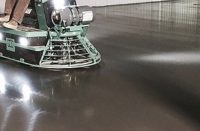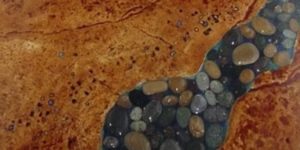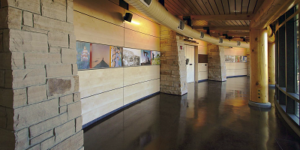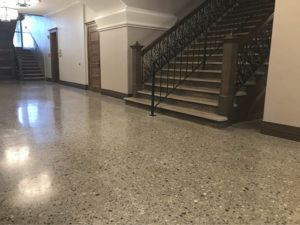
Polished concrete – how does one quantify it? Well, one direction that some installers, equipment makers and chemical densifier manufacturers have taken is to include gloss testing in their specifications. When used correctly, as an objective tool, gloss testing can help installers provide quantifiable evidence of their work. However, when used incorrectly, as a subjective tool, it can lead to false and often unsustainable expectations for the owner.
According to promotional copy from Alpha Professional Tools, portable gloss meters “enable quick, accurate measurements of gloss on flat, polished surfaces. This allows the service provider to ensure quality control and set a quality standard for floor restoration and fabrication work. It also allows the service provider to demonstrate before and after results.” (My italics.)

Gloss readings are achieved by measuring the reflective index of light. However, when checking the gloss of a surface, physical properties of the surface (uniformity, surface irregularities) must be taken into account. It is one thing to check a homogenous surface, such as glass, but measuring the gloss of ground and polished concrete is an entirely different situation. Looking at the two small sample photos on this page, note the visually obvious differences. Sample 1 is concrete with exposed aggregate, and sample 2 is a salt-and-pepper look. It is evident that each sample is different in appearance, and it is these graphic differences that dictate the need to rein in the misuse of gloss readings as a subjective tool in specifications.
When utilized correctly, gloss testing on polished concrete must be used only as an objective means to show a change from point A to point B, not a comparison between slab A and slab B, or pour A and pour B. To state in specifications that “Level 1” must be a reading of 35, “Level 2” must be 60 and “Level 3” must be 80 ignores what every knowledgeable installer educates his customers about. Concrete is a natural product. It is influenced by the weather and the finisher, and no two slabs or two grains of sand are exactly alike, and if no two slabs or grains are alike, neither will two reflections be. Therefore, your gloss unit (GU) readings will naturally vary from point to point.
When you look at the two series of photos at right, you will note different GU readings – three from the same exposed aggregate sample and three from the salt-and-pepper sample. The range of GU readings varies by more than 20 GU on the exposed aggregate and by more than 16 GU on the salt-and-pepper. This is a variance of between 20 percent and 37 percent, and the variances were found within a 6-by-12-inch sample area.
These samples were not created on concrete poured as test samples but on an actual, existing 20-year-old slab that was ground, polished and chemically densified. Clarity was achieved – the finished floor was uniform in appearance and gained great reflectivity. What these photos and testing verify is that inconsistencies will occur within any concrete slab, and that to use gloss testing as a finite tool is unrealistic, while using it as a comparative testing tool will allow you to provide your customer with an objective way to quantify gain (and polishing skills) in gloss.
When I was talking with Bill Jones, president of Substrate Technology Inc., the manufacturer of Prep/Master grinding and polishing equipment, he stated that he likes to see an installer provide a GU number as a qualitative number to shoot for, but not necessarily the endpoint that one will always achieve. In addition, he noted that having GU readings as a guideline, not an absolute, allows the installer the opportunity to renegotiate, or if necessary, walk away from a potential disaster if steps required fall outside the bid. Without doing a test, one cannot know what steps are required and what GU reading can be achieved.
Whether your final look is cream, salt-and-pepper or exposed aggregate, the floor will dictate what GU you can achieve, and even then you need to have allowances for variations within each slab.
And if the means for reaching a stated GU was applying a “guard” product, than you have delivered an artificial “sealed” result, not that of polished and chemically densified concrete. “Guard” products have their place, but not if they are used solely to increase GU readings. One can take a hard steel-trowel finish with an initial GU of 8, apply a “guard” sealer and achieve a GU of 44, but you haven’t delivered a permanent GU increase, nor have you delivered a true polished floor.
Take a floor to 400 grit, apply a densifier, and then use your “guard” product. Do you sell this as a polished, chemically densified floor? The answer should be an emphatic “No!” If your answer was yes, then with a little thought, it should dawn on you why our customers are confused about what polished concrete truly is.

















